2021-06-10 - Nº 319
Editorial
Esta é a Newsletter Nº 319 que se apresenta com o mesmo formato que as anteriores. Se gostar da Newsletter partilhe-a!
Todas as Newsletters encontram-se indexadas no link.
Esta Newsletter tem os seguintes tópicos:
Faz hoje anos que nascia, em 1706, o fabricante inglês de instrumentos ópticos e astronómicos John Dollond. Ele desenvolveu (1758) e patenteou um telescópio refractor acromático (sem distorção de cor) e um heliometro prático, um telescópio usado para medir o diâmetro do Sol e os ângulos entre os corpos celestes. Na década de 1730, Chester More Hall, um advogado com interesse em telescópios, descobriu pela primeira vez que o vidro de sílex parecia ter uma dispersão de cor maior do que o vidro da coroa com as mesmas ampliações. Hall concluiu que se ele cimentasse a face côncava de uma lente de sílex à face convexa de uma lente de vidro coroa, ele podia remover as propriedades de dispersão (e, portanto, a aberração cromática) de ambas as lentes simultaneamente. Dollond aprendeu a técnica na década de 1750 e desenvolveu-a.
Faz também hoje anos que nascia, em 1710, o óptico e astrónomo britânico James Short. Ele produziu os primeiros espelhos verdadeiramente parabólicos e elípticos (portanto, quase sem distorção) para telescópios reflectores. Durante a sua vida profissional de mais de 35 anos, Short fez cerca de 1.360 instrumentos - não apenas para clientes na Grã-Bretanha, mas também para exportação: um ainda está preservado em Leninegrado, outro em Uppsala e vários na América. Short foi o principal calculador das observações do Trânsito de Vénus feitas em todo o mundo em 6 de Junho de 1761. Os seus instrumentos viajaram no Endeavour com o Capitão Cook para observar o próximo Trânsito de Vénus em 3 de Junho de 1769, mas Short morreu antes que esse evento acontecesse.
Faz igualmente hoje anos que nascia, em 1803, o engenheiro hidráulico francês Henry Darcy. Ele foi o primeiro que derivou a equação (agora conhecida como lei de Darcy) que governa o fluxo laminar (não turbulento) de fluidos em meios homogéneos e porosos. Em 1856, os estudos modernos das águas subterrâneas começaram quando Darcy foi contratado para desenvolver um sistema de purificação de água para a cidade de Dijon, França. Ele construiu o primeiro aparato experimental para estudar as características do fluxo da água através da terra. A partir das suas experiências, ele derivou a equação da Lei de Darcy, que descreve o fluxo da água na natureza, que é fundamental para a compreensão dos sistemas de água subterrânea. Ele realizou testes extensivos de filtragem e resistência do tubo.
Faz também hoje anos que nascia, em 1832, o engenheiro e inventor alemão Nicolaus Otto. Ele desenvolveu o motor de combustão interna de quatro tempos, que ofereceu a primeira alternativa prática ao motor a vapor como fonte de energia. Um engenheiro francês, Alphonse Beau de Rochas, formulou o projecto básico para o motor de combustão interna de quatro tempos e patenteou-o em 1862, mas nunca construiu um modelo funcional. Em 1876, Otto usou princípios de Beau de Rochas e outros para construir o protótipo dos motores de automóveis de hoje, muitas vezes chamados de motor de ciclo Otto. Ele vendeu milhares de cópias antes que Beau de Rochas o processasse e invalidasse a patente de Otto. Mas motores leves e eficientes do ciclo Otto possibilitaram em grande parte a criação de automóveis, barcos a motor, motocicletas e até aviões.
Por fim, faz hoje anos que nascia, em 1927, o físico americano Eugene Parker. Ele fez extensas pesquisas sobre o vento solar e os efeitos dos campos magnéticos na heliosfera. Além de aumentar a compreensão da coroa solar, seu trabalho investigou as complexas interacções electromagnéticas tanto no sol quanto em sua interacção com o campo magnético terrestre. Ele viveu para ver modelos teóricos (que ele desenvolveu antes da era espacial) serem confirmados por sondas espaciais na heliosfera. As suas ideias originais foram formadas a partir das informações limitadas disponíveis a partir de observações das caudas dos cometas à medida que eram modificados a viajar perto do sol. Ele cunhou o nome de “vento solar” na década de 1950, para a cascata de energia quando propôs como nosso sol (e outras estrelas) emitem energia.
A 1752, Benjamin Franklin usa um papagaio durante uma tempestade e carrega a carga eléctrica ambiente numa jarra de Leyden, permitindo-lhe demonstrar a conexão entre relâmpagos e electricidade. Franklin interessou-se por electricidade em meados da década de 1740, uma época em que ainda se desconhecia muito sobre o assunto, e passou quase uma década a realizar experiências com electricidade. Ele cunhou vários termos usados hoje, incluindo bateria, condutor e electricista. Ele também inventou o pára-raios, usado para proteger edifícios e navios.
Nesta semana que passou o helicóptero Ingenuity completa o seu sétimo voo na superfície de Marte. O helicóptero de 1,8 quilos voltou aos céus marcianos na terça-feira (8 de Junho), fazendo a sua primeira saída desde que lutou contra uma anomalia em voo, a 22 de Maio. E não houve problemas desta vez.
Na Newsletter desta semana apresentamos diversas noticias, artigos científicos, projetos de maker assim como alguns videos interessantes. É apresentado o livro "The Computers That Made Britain"
 João Alves ([email protected])
João Alves ([email protected])
O conteúdo da Newsletter encontra-se sob a licença  Creative Commons Attribution-NonCommercial-ShareAlike 4.0 International License.
Creative Commons Attribution-NonCommercial-ShareAlike 4.0 International License.
Novidades da Semana
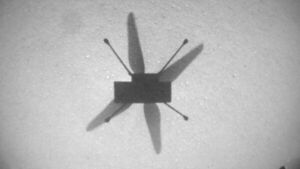
Mars helicopter Ingenuity aces 7th flight on the Red Planet
"NASA's Mars helicopter Ingenuity now has seven Red Planet flights under its belt. The 4-lb. (1.8 kilograms) chopper took to the Martian skies again on Tuesday (June 8), making its first sortie since battling through an in-flight anomaly on May 22. And there were no problems this time around. "From a helicopter team member: 'No anomalies in flight 7, Ingenuity is healthy!' NASA's Jet Propulsion Laboratory (JPL), which manages Ingenuity's mission, wrote via Twitter on Tuesday evening Ingenuity lifted off around 12:34 local mean solar time on Tuesday, which corresponds to 11:54 a.m. EDT (1554 GMT)." [...]
Outras Notícias

NASA Selects 2 Missions to Study ‘Lost Habitable’ World of Venus
"NASA has selected two new missions to Venus, Earth’s nearest planetary neighbor. Part of NASA’s Discovery Program, the missions aim to understand how Venus became an inferno-like world when it has so many other characteristics similar to ours – and may have been the first habitable world in the solar system, complete with an ocean and Earth-like climate. These investigations are the final selections from four mission concepts NASA picked in February 2020 as part of the agency’s Discovery 2019 competition. Following a competitive, peer-review process, the two missions were chosen based on their potential scientific value and the feasibility of their development plans. The project teams will now work to finalize their requirements, designs, and development plans. NASA is awarding approximately $500 million per mission for development." [...]

Hola, South America! Announcing the Firmina subsea cable
"Today, we’re announcing Firmina, an open subsea cable being built by Google that will run from the East Coast of the United States to Las Toninas, Argentina, with additional landings in Praia Grande, Brazil, and Punta del Este, Uruguay. Firmina will be the longest cable in the world capable of running entirely from a single power source at one end of the cable if its other power source(s) become temporarily unavailable—a resilience boost at a time when reliable connectivity is more important than ever. As people and businesses have come to depend on digital services for many aspects of their lives, Firmina will improve access to Google services for users in South America. With 12 fiber pairs, the cable will carry traffic quickly and securely between North and South America, giving users fast, low-latency access to Google products such as Search, Gmail and YouTube, as well as Google Cloud services. Single-end power source capability is important for reliability, a key priority for Google’s network. With submarine cables, data travels as pulses of light inside the cable’s optical fibers." [...]

Page-Roberts reveals EV design concept capable of 30% longer range
"Page-Roberts has revealed a patented design concept for an electric vehicle with world beating efficiency, releasing the potential for 30% greater range for an equivalent battery size. Until now, EV manufacturers have been drawn towards placing the batteries under the floor as a convenient way to package sufficient battery energy for an acceptable range. The drawbacks of this are the added height, added weight, body structural complexities, along with an often-extended wheelbase. The Page-Roberts innovation positions the battery between the front row seats and a second row of rear-facing seats. This arrangement is far more compact than standard electric vehicle designs on the market and offers the exciting potential for a lower, more aerodynamic vehicle with a standard wheelbase. The resulting vehicle will be lighter, more streamlined and up to 30% more efficient." [...]
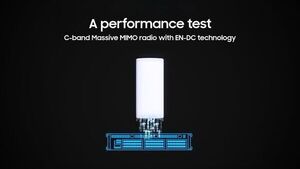
Samsung Achieves Industry First: Expands Virtualized RAN Capability to Support C-Band Massive MIMO Radio
"In additional milestone, Samsung’s Virtualized solution reaches the maximum 5G speeds on C-Band spectrum Samsung Electronics today announced that its commercial 5G virtualized RAN(vRAN) now supports its latest C-Band Massive MIMO radios, a first for the industry and a key milestone in virtualization technology. Additionally, the company achieved a top 5G vRAN speed exceeding 1.5Gbps on C-Band spectrum. With these results – performed in a demonstration at Samsung’s lab in Korea – the company continues to expand the limits of vRAN performance from low-band support last year to mid-band today. Samsung is also currently conducting field trials using these products, and plans to commercialize the solution this year. The demonstration leveraged E-UTRAN New Radio Dual Connectivity (EN-DC) technology combining 40MHz of 4G frequency and 100MHz of 5G frequency on the C-Band spectrum. Through the dual connectivity approach, Samsung achieved 2.25Gbps overall on a single user device." [...]

Radiation-Hardened MOSFET Qualified for Commercial and Military Satellites and Space Power Solutions
"Microchip’s M6 MRH25N12U3 silicon transistor withstands extreme space environments and extends reliability of power circuitry Power supplies in space applications operate in environments that require enhanced radiation technology to withstand extreme particle interactions and solar and electromagnetic events. These events degrade space-based systems and disrupt operations. To meet this requirement, Microchip Technology Inc. (Nasdaq: MCHP) today announced the qualification of its M6 MRH25N12U3 radiation-hardened 250V, 0.21 Ohm Rds(on), metal–oxide–semiconductor field-effect transistor (MOSFET) for commercial aerospace and defense space applications. Microchip’s radiation-hardened M6 MRH25N12U3 MOSFET provides the primary switching element in power conversion circuits including point-of-load converters, DC-DC converters, motor drives and controls and general-purpose switching. The MOSFET withstands the harsh environments of space, extends reliability of power circuitry and meets all requirements of MIL-PRF19500/746 with enhanced performance. Microchip completed testing for Defense Logistics Agency (DLA) review and qualification, for the device’s sourcing in the U.S. military supply chain (expected JANSR2N7593U3 certification in June 2021)." [...]

Maxim Integrated Announces Smallest and Most Accurate Isolated System-Monitoring Solution
"MAX22530 replaces 5 components to shrink solution size by 40 percent and tightens accuracy by 50x to improve system uptime in automated distribution and sub-station applications Maxim Integrated Products, Inc. (NASDAQ: MXIM) today expands the MAXSafe™ Technology line with the MAX22530, an isolated, field-side self-powered 12-bit system monitor. Featuring 4 channels, the MAX22530 provides isolated system monitoring to improve accuracy 50x and to reduce solution size by 40 percent by integrating five components into a single IC. Automation system designers continually seek ways to save board space, increase channel density and improve the accuracy of monitoring voltage and current inputs, so operators can monitor the system with finer precision and reduce system downtimes. The MAX22530 delivers a 50x improvement in monitoring measurement accuracy (from +/- 50 percent to just +/- 1 percent) compared to the standard linear optocoupler isolation solutions made from discretes. It uses Maxim’s unique integrated isolation technology that combines a 12-bit ADC, a DC-DC converter, user-settable threshold detection levels and chip-level diagnostic capabilities. This combination enables 50x greater stability in current transfer ratio performance to achieve an ultra-stable sense resistor voltage." [...]
ON Semiconductor Announces New Full Silicon Carbide MOSFET Module Solutions for Charging Electric Vehicles at APEC 2021
"ON Semiconductor® (Nasdaq:ON), driving energy efficient innovations, has announced a pair of 1200 V full silicon carbide (SiC) MOSFET 2-PACK modules further enhancing their range of products suitable for the challenging electric vehicle (EV) market. As sales of EV continue to grow, infrastructure must be rolled-out to meet the needs of drivers, providing a network of rapid charging stations that will allow them to complete their journeys quickly and without ‘range anxiety’. Requirements in this sector are rapidly evolving, requiring power levels in excess of 350 kW and efficiencies of 95% becoming the ‘norm’. Given the diverse environments and locations in which these chargers are deployed, compactness, robustness and enhanced reliability are all challenges that designers face. The new 1200 V M1 full SiC MOSFET 2 pack modules, based upon planar technology and suited to a drive voltage in the range of 18-20 V, are simple to drive with negative gate voltages. The larger die reduces thermal resistance compared to trench MOSFETs, thereby reducing die temperature at the same operating temperature." [...]

TI bridges the high-speed and precision gap with new SAR ADC family, including the industry's fastest 18-bit ADC
"Engineers can design high-speed digital control loops with the highest dynamic range and lowest latency while reducing power consumption by as much as 65% Texas Instruments (TI) (Nasdaq: TXN) today expanded its portfolio of high-speed data converters with a broad new family of successive-approximation register (SAR) analog-to-digital converters (ADCs) that enable high-precision data acquisition in industrial designs. Featuring best-in-class dynamic range at the lowest power consumption, the ADC3660 family includes eight SAR ADCs in 14-, 16- and 18-bit resolution at sampling speeds ranging from 10 to 125 MSPS, helping designers improve signal resolution, extend battery life and strengthen system protection. For more information, explore the ADC3660 family at www.ti.com/ADC3660family-pr. Increasing the precision of high-speed data acquisition addresses a rising need for real-time control in industrial systems. In a high-speed digital control loop, the ADC acts in a complex system to respond to fast changes in voltage or current to help prevent costly damage to critical components in power-management systems. As the number of data-intensive tasks in industrial systems increases, it becomes more important for the system to make quick decisions to prevent system failure, requiring higher precision at faster speeds." [...]

TSMC’s Chip Scaling Efforts Reach Crossroads at 2nm
"Perpetuating Moore’s Law — the observation that the transistor density in a typical chip doubles every two years — poses a number of challenges at the 3nm node, yet Taiwan Semiconductor Manufacturing Corp. (TSMC) remains optimistic. There are many predictions Moore’s Law is likely to hit a wall soon, but “how soon?” is open to debate. Also, there are technologies that promise ongoing increases in performance that are not dependent on doubling transistor density. The timing of all that will have far-reaching implications. At last week’s TSMC 2021 Technology Symposium, TSMC CEO C. C. Wei gave the example of data centers, which consume over one percent of global electricity generated. “Estimates suggest global electricity usage from data centers is projected to grow from five to forty times between 2010 to 2030." [...]
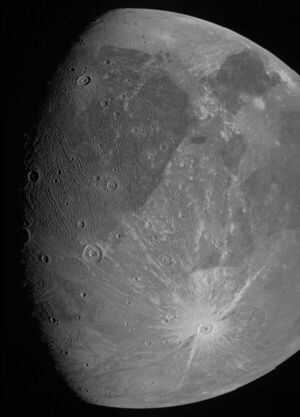
See the First Images NASA’s Juno Took As It Sailed by Ganymede
"The first two images from NASA Juno’s June 7, 2021, flyby of Jupiter’s giant moon Ganymede have been received on Earth. The photos – one from the Jupiter orbiter’s JunoCam imager and the other from its Stellar Reference Unit star camera – show the surface in remarkable detail, including craters, clearly distinct dark and bright terrain, and long structural features possibly linked to tectonic faults. “This is the closest any spacecraft has come to this mammoth moon in a generation,” said Juno Principal Investigator Scott Bolton of the Southwest Research Institute in San Antonio. “We are going to take our time before we draw any scientific conclusions, but until then we can simply marvel at this celestial wonder.” Using its green filter, the spacecraft’s JunoCam visible-light imager captured almost an entire side of the water-ice-encrusted moon. Later, when versions of the same image come down incorporating the camera’s red and blue filters, imaging experts will be able to provide a color portrait of Ganymede. Image resolution is about 0.6 miles (1 kilometer) per pixel." [...]

NASA’s Perseverance Rover Begins Its First Science Campaign on Mars
"The six-wheeled scientist is heading south to explore Jezero Crater’s lakebed in search of signs of ancient microbial life. On June 1, NASA’s Perseverance Mars rover kicked off the science phase of its mission by leaving the “Octavia E. Butler” landing site. Until recently, the rover has been undergoing systems tests, or commissioning, and supporting the Ingenuity Mars Helicopter’s month of flight tests. During the first few weeks of this first science campaign, the mission team will drive to a low-lying scenic overlook from which the rover can survey some of the oldest geologic features in Jezero Crater, and they’ll bring online the final capabilities of the rover’s auto-navigation and sampling systems. By the time Perseverance completed its commissioning phase on June 1, the rover had already tested its oxygen-generating MOXIE instrument and conducted the technology demonstration flights of the Ingenuity helicopter. Its cameras had taken more than 75,000 images, and its microphones had recorded the first audio soundtracks of Mars." [...]
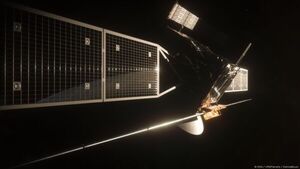
Then There Were 3: NASA to Collaborate on ESA’s New Venus Mission
"As a key partner in the mission, NASA provides the synthetic aperture radar, called VenSAR, to make high-resolution measurements of the planet’s surface features. On June 10, 2021, the European Space Agency (ESA) announced the selection of EnVision as its newest medium-class science mission. EnVision will make detailed observations of Venus to understand its history and especially understand the connections between the atmosphere and geologic processes. As a key partner in the mission, NASA provides the synthetic aperture radar, called VenSAR, to make high-resolution measurements of the planet’s surface features. With significantly higher resolution than that of NASA’s Magellan mission, which captured images of Venus in the early 1990s, VenSAR will improve our understanding of the planet’s surface features. Repeated observations and comparisons with Magellan imagery promise the opportunity for planetary scientists to detect volcanic, tectonic, and geomorphic changes over multiple timescales at a resolution that gets to the level of individual landslides." [...]
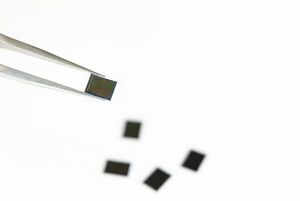
Samsung Breaks New Ground With Mass Production of Industry’s Smallest 0.64μm-Pixel Mobile Image Sensor
"Samsung’s most versatile image sensor offers 50Mp options for both front and rear-facing cameras Combined pixel technology advancements reduce chip size while enhancing light sensitivity and phase detection capabilities Samsung Electronics, a world leader in advanced semiconductor technology, today introduced the industry’s first 0.64-micrometer (μm)-pixel image sensor, the 50-megapixel (Mp) Samsung ISOCELL JN1. Equipped with the latest pixel technologies such as enhanced ISOCELL 2.0, Smart-ISO and Double Super PDAF, the JN1 can capture more vivid images on the industry’s smallest 50Mp mobile sensor. “Samsung’s advanced pixel technologies have once again pushed boundaries with the utmost precision to develop an image sensor with the industry’s smallest pixel size, yet with powerful performance. The new ISOCELL JN1 at 0.64μm will be able to equip tomorrow’s sleekest smartphones with ultra-high resolution mobile photographs,” said Duckhyun Chang, executive vice president of the sensor business at Samsung Electronics. “As we drive our commitment to innovation in pixel technologies, we will continue to bring a wide range of mobile image sensor offerings to the market.” A new addition to Samsung’s high-resolution image sensor lineup, the JN1 employs ISOCELL 2.0 technology with added enhancements that improve light sensitivity by around 16-percent. For low-light environments, the sensor utilizes Samsung’s four-to-one pixel binning technology, Tetrapixel, which merges four adjacent 0.64μm-pixels into one big 1.28μm-pixel to quadruple light sensitivity for brighter 12.5Mp photographs." [...]
Ciência e Tecnologia

Scientists demonstrate a better, more eco-friendly method to produce hydrogen peroxide
"Hydrogen peroxide (H2O2) is used to disinfect minor cuts at home and for oxidative reactions in industrial manufacturing. The pandemic has further fueled demand for this chemical and its antiseptic properties. While affordable at the grocery store, H2O2 is actually difficult and expensive to manufacture at scale. A team led by the University of Illinois Urbana-Champaign has demonstrated a more efficient and environmentally friendly method to produce H2O2, according to a recent study published in the Journal of the American Chemical Society. “While the two ingredients—hydrogen and oxygen—are either inexpensive or freely available from the atmosphere, hydrogen peroxide is highly reactive and unstable, which makes it very hard to produce,” said first author Tomas Ricciardulli, a graduate student in chemical and biomolecular engineering at UIUC. Currently, producing H2O2 requires a complicated, multi-step process and large facilities." [...]
New Form Of Silicon Could Enable Next-Gen Electronic And Energy Devices
"A team led by Carnegie’s Thomas Shiell and Timothy Strobel developed a new method for synthesizing a novel crystalline form of silicon with a hexagonal structure that could potentially be used to create next-generation electronic and energy devices with enhanced properties that exceed those of the “normal” cubic form of silicon used today. Their work is published in Physical Review Letters. Silicon plays an outsized role in human life. It is the second most abundant element in the Earth’s crust. When mixed with other elements, it is essential for many construction and infrastructure projects. And in pure elemental form, it is crucial enough to computing that the longstanding technological hub of the U.S.—California’s Silicon Valley—was nicknamed in honor of it." [...]
Researchers tame silicon to interact with light for next-generation microelectronics
"Skoltech researchers and their colleagues from RAS Institute for Physics of Microstructures, Lobachevsky State University of Nizhny Novgorod, ITMO University, Lomonosov Moscow State University, and A.M. Prokhorov General Physics Institute have found a way to increase photoluminescence in silicon, the notoriously poor emitter and absorber of photons at the heart of all modern electronics. This discovery may pave the way to photonic integrated circuits, boosting their performance. The paper was published in the journal Laser and Photonics Reviews. “Natural selection” in semiconductor technology over almost 80 years has led to silicon emerging as the predominant material for chips. Most digital microcircuits are created using CMOS technology (CMOS), which stands for complementary metal-oxide-semiconductor. Yet manufacturers have hit a wall on the way to increasing their performance even further: heat release due to high density of elements in CMOS circuits." [...]
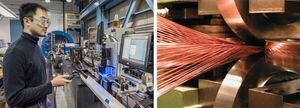
Cabling for Large Hadron Collider Upgrade Project Reaches Halfway Mark
"Magnetic cable project will extend the reach of CERN’s high-energy physics collider The U.S. Department of Energy’s (DOE) Lawrence Berkeley National Laboratory (Berkeley Lab) has passed the halfway mark in the multi-year process of fabricating crucial superconducting cables as part of a project to upgrade the Large Hadron Collider (LHC) at CERN. This upgrade, now in progress, will greatly increase the facility’s collision rate and its scientific productivity. The High-Luminosity LHC Accelerator Upgrade Project, or HL-LHC AUP, is a multi-institutional, U.S. contribution to the upgrade of the LHC facility. The project is headquartered at DOE’s Fermi National Accelerator Laboratory (Fermilab). A group of much more powerful focusing magnets, known as the “inner triplet,” are planned to be installed on either side of the LHC’s interaction points, where the separate proton beams collide. By squeezing the beams to higher density at the interaction points, these stronger focusing magnets will increase the number of collisions over the lifetime of the machine by at least a factor of 10." [...]
Efficiently "switching on” bacteria to produce high-value chemicals
"- Most high-value chemicals are currently produced using fossil fuels - industrial chemistry's use of petroleum accounts for 14% of all greenhouse gas emissions. - An exciting alternative is to engineer bacteria as “cell-factories” with a genetic switch that reroutes their chemistry to produce high-value chemicals, such as biofuels, polymers and pharmaceuticals. - The use of expensive chemicals to switch them on severely limits their commercial potential, researchers have used mathematical models to develop a new genetic switch that can use a cheap natural nutrient to switch on production permanently – drastically reducing that cost. - This brings closer the realization of sustainable and economically viable industrial-scale production of high-value chemicals from cheap feedstocks, for a greener, cleaner future. High-value chemicals used in biofuels and pharmaceuticals can be made from bacteria by switching their chemistry to produce novel products. Researchers from the University of Warwick have found a way to drastically cut the cost of turning on these switches." [...]
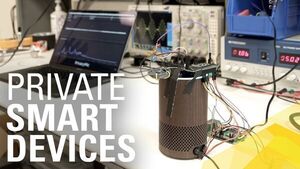
Less nosy smart speakers
"Technology could capture household information without recording speech. Microphones are perhaps the most common electronic sensor in the world, with an estimated 320 million listening for our commands in the world’s smart speakers. The trouble, of course, is that they’re capable of hearing everything else, too. But now, a team of University of Michigan researchers has developed a system that can inform a smart home—or listen for the signal that would turn on a smart speaker—without eavesdropping on audible sound. The key to the device, called PrivacyMic, is ultrasonic sound at frequencies above the range of human hearing. Running dishwashers, computer monitors, even finger snaps, all generate ultrasonic sounds, which have a frequency of 20 kilohertz or higher." [...]
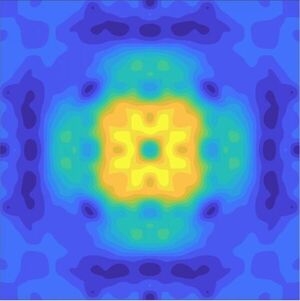
An atomic look at lithium-rich batteries
"An international team of collaborators has made the first direct observation of the anionic redox reaction in a lithium-rich battery material. The research opens up pathways for improving existing battery cathodes—and designing new ones. Batteries have come a long way since Volta first stacked copper and zinc discs together 200 years ago. While the technology has continued to evolve from lead-acid to lithium-ion, many challenges still exist—like achieving higher density and suppressing dendrite growth. Experts are racing to address the growing, global need for energy-efficient and safe batteries. The electrification of heavy-duty vehicles and aircraft requires batteries with more energy density." [...]
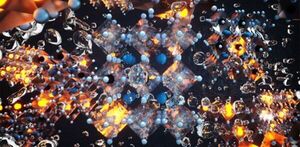
Atom swapping could lead to ultra-bright, flexible next generation LEDs
"An international group of researchers has developed a new technique that could be used to make more efficient low-cost light-emitting materials that are flexible and can be printed using ink-jet techniques. The researchers, led by the University of Cambridge and the Technical University of Munich, found that by swapping one out of every one thousand atoms of one material for another, they were able to triple the luminescence of a new material class of light emitters known as halide perovskites. This ‘atom swapping’, or doping, causes the charge carriers to get stuck in a specific part of the material’s crystal structure, where they recombine and emit light. The results, reported in the Journal of the American Chemical Society, could be useful for low-cost printable and flexible LED lighting, displays for smartphones or cheap lasers. Many everyday applications now use light-emitting devices (LEDs), such as domestic and commercial lighting, TV screens, smartphones and laptops. The main advantage of LEDs is they consume far less energy than older technologies." [...]
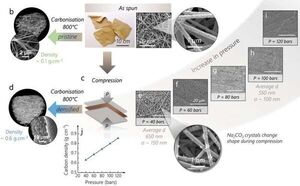
New generation of supercapacitors set to electrify green transportation
"Scientists have created a new generation of low-cost, high-energy supercapacitors to power electric vehicles. Researchers from Imperial College London and University College London (UCL) have produced a cheaper, more sustainable and energy-dense electrode material for supercapacitors which could pave the way for wider market penetration of this high-power, quick charging electric vehicle technology. In the study, published in Advanced Science, the team used lignin, a bio-based by-product of the paper industry, to create free-standing electrodes with enhanced energy storage capacity. The researchers say that this could be a game-changer for existing supercapacitor technology, providing a cheaper, more sustainable alternative to current models. The team emphasise the importance of reducing the production cost of carbon-based electrodes and the reliance on critical materials if free-standing supercapacitors are to play a major role in decarbonising the transportation industry alongside batteries and fuel cells. Sustainable materials Using lignin in place of expensive graphene-based carbon, the team produced a freestanding structure which is lighter and smaller than current models without compromising energy storage capacity." [...]

Online 'library of properties' helps to create safer nanomaterials
"Researchers have developed a ‘library of properties’ to help identify the environmental impact of nanomaterials faster and more cost effectively. Whilst nanomaterials have benefited a wide range of industries and revolutionised everyday life, there are concerns over potential adverse effects - including toxic effects following accumulation in different organs and indirect effects from transport of co-pollutants. The European Union H2020-funded NanoSolveIT project is developing a ground-breaking computer-based Integrated Approach to Testing and Assessment (IATA) for the environmental health and safety of nanomaterials. Over the last two years, researchers from the University of Birmingham have worked with experts at NovaMechanics, in Nicosia, Cyprus to develop a decision support system in the form of both stand-alone open software and a Cloud platform. The team has developed a freely available cloud library containing full physicochemical characterisation of 69 nanomaterials, plus calculated molecular descriptors to increase the value of the available information, details of which are published in NanoImpact. Professor Iseult Lynch, from the University of Birmingham commented: “One of the limitations to widespread application of computer-based approaches is the lack of large well-organised high-quality datasets, or of data with adequate metadata that will allow dataset interoperability and their combination to create larger datasets." [...]
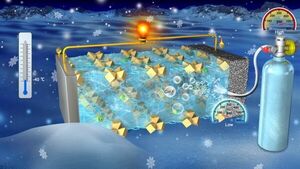
Stabilizing Gassy Electrolytes Could Make Ultra-Low Temperature Batteries Safer
"A new technology could dramatically improve the safety of lithium-ion batteries that operate with gas electrolytes at ultra-low temperatures. Nanoengineers at the University of California San Diego developed a separator—the part of the battery that serves as a barrier between the anode and cathode—that keeps the gas-based electrolytes in these batteries from vaporizing. This new separator could, in turn, help prevent the buildup of pressure inside the battery that leads to swelling and explosions. “By trapping gas molecules, this separator can function as a stabilizer for volatile electrolytes,” said Zheng Chen, a professor of nanoengineering at the UC San Diego Jacobs School of Engineering who led the study. The new separator also boosted battery performance at ultra-low temperatures. Battery cells built with the new separator operated with a high capacity of 500 milliamp-hours per gram at -40 C, whereas those built with a commercial separator exhibited almost no capacity." [...]

Physicists determine how auroras are created
"The aurora borealis, or northern lights, that fill the sky in high-latitude regions have fascinated people for thousands of years. But how they’re created, while theorized, had not been conclusively proven. In a new study, a team of physicists led by University of Iowa reports definitive evidence that the most brilliant auroras are produced by powerful electromagnetic waves during geomagnetic storms. The phenomena, known as Alfven waves, accelerate electrons toward Earth, causing the particles to produce the familiar atmospheric light show. The study, published online June 7 in the journal Nature Communications, concludes a decades-long quest to demonstrate experimentally the physical mechanisms for the acceleration of electrons by Alfven waves under conditions corresponding to Earth’s auroral magnetosphere. “Measurements revealed this small population of electrons undergoes ‘resonant acceleration’ by the Alfven wave’s electric field, similar to a surfer catching a wave and being continually accelerated as the surfer moves along with the wave,” says Greg Howes, associate professor in the Department of Physics and Astronomy at Iowa and study co-author." [...]
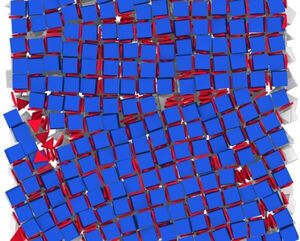
Nanoengineering integrates crystals that don’t usually get along
"A team of computational and experimental engineers demonstrate a blueprint for building materials with new properties from nanocrystals A blueprint for designing new materials using difficult combinations of nanocrystals has been developed by a team of researchers at the University of Pennsylvania and the University of Michigan. The work could lead to improvements in nanocrystals already used in displays, medical imaging and diagnostics, and enable new materials with previously impossible properties. Researchers can make materials with new and interesting properties by bringing together nanocrystals of different compositions, sizes and shapes. The challenge is doing that in an organized way. Now, the Penn and U-M team have developed a strategy that explores the available nanoparticles and figures out how to stick them together. “It’s one of those problems where ‘like likes like,'” said recent Ph.D. graduate Katherine Elbert, who led this study while working in the lab of Chris Murray, a Penn Integrates Knowledge (PIK) Professor in materials science and engineering." [...]

Tiny particles power chemical reactions
"A new material made from carbon nanotubes can generate electricity by scavenging energy from its environment. MIT engineers have discovered a new way of generating electricity using tiny carbon particles that can create a current simply by interacting with liquid surrounding them. The liquid, an organic solvent, draws electrons out of the particles, generating a current that could be used to drive chemical reactions or to power micro- or nanoscale robots, the researchers say. “This mechanism is new, and this way of generating energy is completely new,” says Michael Strano, the Carbon P. Dubbs Professor of Chemical Engineering at MIT. “This technology is intriguing because all you have to do is flow a solvent through a bed of these particles. This allows you to do electrochemistry, but with no wires.” In a new study describing this phenomenon, the researchers showed that they could use this electric current to drive a reaction known as alcohol oxidation — an organic chemical reaction that is important in the chemical industry." [...]
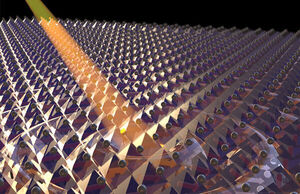
Lighting Up Ultrafast Magnetism in a Metal Oxide
"Understanding how magnetic correlations change over very short timescales could be harnessed to control magnetism for applications including data storage and superconductivity What happens when very short pulses of laser light strike a magnetic material? A large international collaboration led by the U.S. Department of Energy’s (DOE) Brookhaven National Laboratory set out to answer this very question. As they just reported in the Proceedings of the National Academy of Sciences, the laser suppressed magnetic order across the entire material for several picoseconds, or trillionths of a second. Understanding how magnetic correlations change on ultrafast timescales is the first step in being able to control magnetism in application-oriented ways. For example, with such control, we may be able to more quickly write data to memory devices or enhance superconductivity (the phenomenon in which a material conducts electricity without energy loss), which often competes with other states like magnetism. The material studied was strontium iridium oxide (Sr3Ir2O7), an antiferromagnet with a bilayer crystal structure and a large magnetic anisotropy." [...]

Ultra-high-density hard drives made with graphene store ten times more data
"Graphene can be used for ultra-high density hard disk drives (HDD), with up to a tenfold jump compared to current technologies, researchers at the Cambridge Graphene Centre have shown. The study, published in Nature Communications, was carried out in collaboration with teams at the University of Exeter, India, Switzerland, Singapore, and the US. HDDs first appeared in the 1950s, but their use as storage devices in personal computers only took off from the mid-1980s. They have become ever smaller in size, and denser in terms of the number of stored bytes. While solid state drives are popular for mobile devices, HDDs continue to be used to store files in desktop computers, largely due to their favourable cost to produce and purchase. HDDs contain two major components: platters and a head." [...]
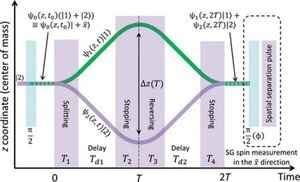
An atom chip interferometer that could detect quantum gravity
"Physicists in Israel have created a quantum interferometer on an atom chip. This device can be used to explore the fundamentals of quantum theory by studying the interference pattern between two beams of atoms. University of Groningen physicist, Anupam Mazumdar, describes how the device could be adapted to use mesoscopic particles instead of atoms. This modification would allow for expanded applications. A description of the device, and theoretical considerations concerning its application by Mazumdar, were published on 28 May in the journal Science Advances. The device which scientists from the Ben-Gurion University of the Negev created is a so-called Stern Gerlach Interferometer, which was first proposed one hundred years ago by German physicists Otto Stern and Walter Gerlach." [...]
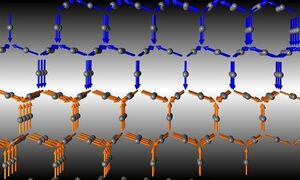
Magnetism Drives Metals to Insulators in New Experiment
"Like all metals, silver, copper, and gold are conductors. Electrons flow across them, carrying heat and electricity. While gold is a good conductor under any conditions, some materials have the property of behaving like metal conductors only if temperatures are high enough; at low temperatures, they act like insulators and do not do a good job of carrying electricity. In other words, these unusual materials go from acting like a chunk of gold to acting like a piece of wood as temperatures are lowered. Physicists have developed theories to explain this so-called metal–insulator transition, but the mechanisms behind the transitions are not always clear. "In some cases, it is not easy to predict whether a material is a metal or an insulator," explains Caltech visiting associate Yejun Feng of the Okinawa Institute for Science and Technology Graduate University." [...]
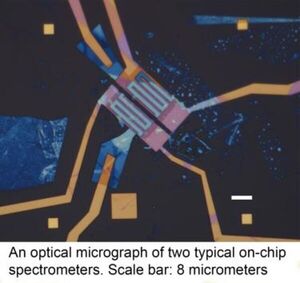
Researchers make ultracompact on-chip computational infrared spectrometer
"An international team of researchers has developed a mid-infrared spectrometer smaller than the diameter of a human hair. With potential applications that range from detecting greenhouse gases to making self-driving vehicles safer, there has been a great deal of interest in recent years in developing compact, on-chip spectrometers. Traditional spectrometers, which measure the spectral information of light, are bulky and expensive. An on-chip spectrometer would greatly expand the applications and accessibility of the technology. Toward this goal, a team of researchers in the U.S., Israel, and Japan has developed an ultracompact mid-infrared spectrometer. The work is the result of a collaboration between the laboratory of Fengnian Xia, the Barton L. Weller Associate Professor in Engineering and Science at Yale University; Professor Doron Naveh of Bar-Ilan University, Israel; Kenji Watanabe and Takashi Taniguchi of National Institute for Materials Science, Japan." [...]

New light on making two-dimensional polymers
"An international research team with members from Linköping University, the Deutsches Museum and the Technical University of Munich, among others, has developed a method to manufacture two-dimensional polymers with the thickness of a single molecule. The polymers are formed on a surface by the action of light. The discovery paves the way to new ultrathin and functional materials, and has been published in Nature Chemistry. The quest for new two-dimensional materials has rapidly intensified after the discovery of graphene – a supermaterial whose excellent properties include high conductivity and strength, making it incredibly versatile. Two main approaches are used to create ultrathin materials. In the first, a continuous layer of molecules or atoms is “peeled off” from the bulk of the material." [...]
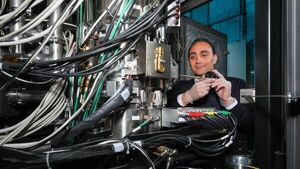
Microscope reveals the secrets of a material's structure
"EPFL scientists have made an important discovery about the structure of barium titanate, a material used in everyday objects. Their findings refute existing theories on the displacement of the material’s atoms. Barium titanate is a ferroelectric material used in nearly all electronic devices – computers, smartphones and even electric cars. It’s used to make the sensors and capacitors they run on, for example. “A single smartphone generally has around 700 capacitors containing barium titanate, and trillions of these capacitors are made every year,” says Dragan Damjanovic, an EPFL professor and head of the Group for Ferroelectrics and Functional Oxides at EPFL’s School of Engineering. Despite barium titanate’s widespread use, however, researchers still don’t fully understand how it works." [...]

China maintains 'artificial sun' at 120 million Celsius for over 100 seconds, setting new world record
"China broke the record by keeping the Experimental Advanced Superconducting Tokamak (EAST) by achieving plasma temperature at 120 million Celsius for 101 seconds and 160 million Celsius for 20 seconds, a major step toward the test run of the fusion reactor. The Tokamak devise is located at the Hefei Institutes of Physical Science of the Chinese Academy of Sciences. It is designed to replicate the nuclear fusion process that occurs naturally in the sun and stars to provide almost infinite clean energy through controlled nuclear fusion, which is often dubbed the "artificial sun." The achievement broke a previous record of maintaining the plasma temperature at 100 million C for 100 seconds. According to Li Miao, director of the physics department of the Southern University of Science and Technology in Shenzhen, it is a milestone in reaching the goal of keeping the temperature at a stable level for a long time. "The breakthrough is significant progress, and the ultimate goal should be keeping the temperature at a stable level for a long time," Li told the Global Times, adding that the next milestone might be to maintain the stability for a week or more." [...]

New drug-formulation method may lead to smaller pills
"Chemical engineers have found a way to load more drug into a tablet, which could then be made smaller and easier to swallow. About 60 percent of drugs on the market have hydrophobic molecules as their active ingredients. These drugs, which are not soluble in water, can be difficult to formulate into tablets because they need to be broken down into very small crystals in order to be absorbed by the human body. A team of MIT chemical engineers has now devised a simpler process for incorporating hydrophobic drugs into tablets or other drug formulations such as capsules and thin films. Their technique, which involves creating an emulsion of the drug and then crystallizing it, allows for a more powerful dose to be loaded per tablet. “This is very important because if we can achieve high drug loading, it means that we can make smaller dosages that still achieve the same therapeutic effect." [...]

Quality Campaign for Better Batteries
"Powerful, durable, and safe: these properties, combined with a low price, could soon secure batteries “Made in Germany” a place among the best in the world. This will be realized by including advanced approaches to quality assurance and analytics in production, which are now being developed and tested at the Karlsruhe Institute of Technology (KIT). The activities in the AQua battery research cluster are carried out in close cooperation with research partners in the “Battery research factory” initiated by the Federal Ministry of Education and Research (BMBF). Ensuring maximum quality at minimum production costs – this is what scientists strive to achieve in a new research platform launched at KIT as part of the AQua (stands for: analytics/quality assurance) battery competence cluster. To do this, they first look at each production step, from the raw materials to the finished cell, in order to identify possible sources of errors. Subsequent measures include the optimization and automation of error handling during ongoing production so that a consistently high quality can be guaranteed in the end." [...]

Mixing solutions in the world’s smallest test tubes
"Researchers based at The University of Manchester have demonstrated a new method for imaging live chemical reactions with atomic resolution using nanoscale test tubes created using two-dimensional (2D) materials. The ability to observe solution-based chemical reactions with sub-nanometre resolution in real time has been highly sought after since the invention of the electron microscope 90 years ago. Imaging the dynamics of a reaction can provide mechanistic insights and signpost strategies for tailoring the properties the resulting materials. A transmission electron microscope (TEM) is one of a few instruments capable of resolving individual atoms, though conventionally it requires completely dry samples imaged in a vacuum environment, precluding any wet chemical synthesis. Based on previous work developing graphene liquid cells that allow TEM imaging of liquid-phase nanostructures, a team of researchers based at The University of Manchester’s National Graphene Institute, collaborating with researchers at the Leibniz University Hannover, have shown that two solutions can be mixed inside the microscope and imaged in real time. The new research, published today in Advanced Materials details a new imaging platform that has been used to investigate the growth of calcium carbonate." [...]

Scientists Make Quantum Germanium “Islands” Glow With Hundredfold Intensity
"A team of Russian scientists including researchers from ITMO University, A.M. Prokhorov General Physics Institute, the Institute for Physics of Microstructures of the Russian Academy of Sciences, Skolkovo Institute of Science and Technology, and Lomonosov Moscow State University succeeded in enhancing the luminance of quantum dots on a silicon substrate. The methods used by the scientists can help create next generation microchips that will receive and transfer information from a computer to a fiber-optic network a lot faster. The article was published in Laser & Photonics Review. Modern computers that are based on silicon microcircuits can do millions of operations a second. Fiber-optic communication lines give us the opportunity to transfer terabytes of information between buildings, cities and even continents. Issues arise at the interface between the chip and the cable, when it is necessary to transform the electric signal that encodes information into a luminous signal that goes to a server, and vice-versa." [...]

MIT study compares the four largest internet meganetworks
"With thousands of satellites, each network could beam down tens of terabits per second, filling gaps left by land-based services. The team estimated each network’s total throughput based on the most recent petitions filed by each company to the FCC. Petitions include technical specifications such as the total number of satellites, the planes and inclination angles at which they will orbit, and the communication capabilities between satellites. Using these data, the team created simulations of each network’s satellite configuration and ran the simulations over a single day, taking “snapshots” every minute of each satellite’s position in the sky. They also recorded its cone of coverage, or the volume of space over which a satellite could communicate in that moment. The researchers used an atmospheric model to vary the surrounding conditions in the moment, as well as a demand model that estimated the number of users within the satellite’s coverage area, based on a grid map of world population." [...]
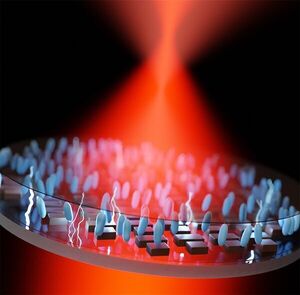
Novel liquid crystal metalens offers electric zoom
"Researchers from Cornell’s School of Applied and Engineering Physics and Samsung’s Advanced Institute of Technology have created a first-of-its-kind metalens – a metamaterial lens – that can be focused using voltage instead of mechanically moving its components. The proof of concept opens the door to a range of compact varifocal lenses for possible use in many imaging applications such as satellites, telescopes and microscopes, which traditionally focus light using curved lenses that adjust using mechanical parts. In some applications, moving traditional glass or plastic lenses to vary the focal distance is simply not practical due to space, weight or size considerations. Metalenses are flat arrays of nano-antennas or resonators, less than a micron thick, that act as focusing devices. But until now, once a metalens was fabricated, its focal length was hard to change, according to Melissa Bosch, doctoral student and first author of a paper detailing the research in the American Chemical Society’s journal Nano Letters. The innovation, developed in the collaboration between Samsung and Cornell researchers, involved merging a metalens with the well-established technology of liquid crystals to tailor the local phase response of the metalens." [...]
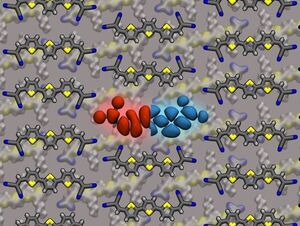
Tuning The Energy Gap: A Novel Approach For Organic Semiconductors
"What is already established for inorganic semiconductors stays a challenge for their organic counterparts: Tuning the energy gap by blending different semiconducting molecules to optimize device performance. Now, scientists from TU Dresden, in cooperation with researchers at TU Munich, as well as University of Würzburg, HU Berlin, and Ulm University demonstrated how to reach this goal. Organic semiconductors have earned a reputation as energy efficient materials in organic light emitting diodes (OLEDs) that are employed in large area displays. In these and in other applications, such as solar cells, a key parameter is the energy gap between electronic states. It determines the wavelength of the light that is emitted or absorbed. The continuous adjustability of this energy gap is desirable." [...]

Researchers Realize Unconventional Coherent Control of Solid-state Spin Qubits
"The research team led by Prof. GUO Guangcan from the University of Science and Technology of China (USTC) of the Chinese Academy of Sciences (CAS), together with Prof. Adam Gali from Wigner Research Centre for Physics, realized robust coherent control of solid-state spin qubits using anti-Strokes (AS) excitation, broadening the boundary of quantum information processing and quantum sensing. This study was published in Nature Communications. Solid-state color center spin qubits play an important role in quantum computing, quantum networks and high-sensitivity quantum sensing. Considered as the basis of quantum technology application, optically detected magnetic resonance (ODMR) technology offers a readout approach to detect the spin state. Conventional ODMR detection of solid-state spin states is almost all under Strokes excitation, which requires that the excitation laser has higher energy than emitted photons. To extend the scope of solid-state quantum technologies, the researchers first realized the AS excited ODMR detection of silicon vacancy defect spin in silicon carbide (SiC), where the energy of exciting laser is lower than that of the emission photons." [...]
Documentação
A documentação é parte essencial do processo de aprendizagem e a Internet além de artigos interessantes de explorar também tem alguma documentação em formato PDF interessante de ler. Todos os links aqui apresentados são para conteúdo disponibilizado livremente pelo editor do livro.
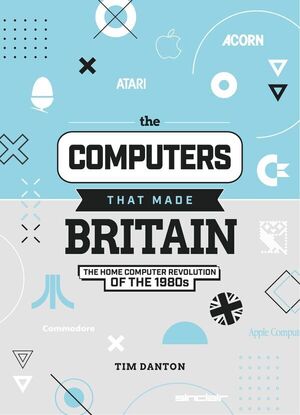
The Computers That Made Britain
"INSIDE THE HOME COMPUTER REVOLUTION OF THE 1980s The home computer boom of the 1980s brought with it now iconic machines such as the ZX Spectrum, BBC Micro, and Commodore 64. Those machines would inspire a generation. Written by Tim Danton. The Computers That Made Britain (300 pages, hardback) tells the story of 19 of those computers – and what happened behind the scenes. With dozens of new interviews, discover the tales of missed deadlines, technical faults, business interference, and the unheralded geniuses who brought to the UK everything from the Dragon 32 and ZX81, to the Amstrad CPC 464 and Commodore Amiga. Best-selling author and journalist Stuart Turton says: The Computers that Made Britain is one of the best things I’ve read this year." [...]
Projetos Maker
Diversos Projetos interessantes.

LED Running Lights
"In todays article, I will show you running lights based on three popular microcircuits: an operational amplifier microcircuit LM358, a timer microcircuit NE555, and decimal counter microcircuit CD4017. The running lights schematic diagram and printed circuit board (PCB) were developed in Easy EDA online environment. The device schematic diagram consists of four parts, such as a microphone amplifier, an impulse generator, a ten-digit counter and LED indicators. This device works in such a way that the microphone signal, after amplification and smoothing, is converted into a voltage with level proportional to the signal amplitude. This voltage is applied to an impulse generator based on the microcircuit NE555. Then the impulse generator signal arrives to the input of the ten-digit counter CD4017." [...]

Planck Constant Apparatus and Calculations
"Planck constant (h) is one of the fundamental physics constants and the most important constant in quantum mechanics. When I was studying physics years ago, I fall in love with Quantum Mechanics and now I have decided to conduct simple experiment to calculate Planck constant at home. In this instructables I will show you how to make an apparatus that can be used to calculate Planck constant and, also how to measure the turn-on voltage and IV characteristic for different colour LEDs. This time I only used hand tools so anyone can make it at home. NOTE: Optionally I have included files for 3D printing and laser cutting in case you have an access to any of that equipment. Supplies - 220 Ohm 0.5W resistor - 2k Ohm potentiometer - 12-way rotary switch (1P12T) - 6 x 4mm banana terminals (3 black, 3 red) - 3 x 4mm banana leads - Potentiometer knob (optional) - Rotary switch knob (optional) - 300mm x 100mm x 3mm perspex - 4 rubber feet - 8mm OD Perspex tube (optional) - A4 sticky label sheet - Red, Orange, Yellow, Green, Blue, Purple LEDs - Cyan LED - IR 850 LED - IR 940 LED - Equipment wire Tools: - 5V power supply - Jigsaw - Dril - Voltmeter - Ameter (optional) - Soldering iron - Equipment wire - Ink/laser printer - CO2 laser cutter (optional) - 3D printer (optional) - Wire strippers/cutters" [...]

Smart RGB Lamp Controlled Via ESP NOW
"In this project I'm going to show you how to make a smart RBG lamp which can be easily controlled remotely using the ESP NOW protocol. Version without remote control: 1) ESP32 x1 2) 128x32 OLED display x1 3) 470 ohm resistor x1 4) 20k potentiometers x3 5) Buttons x2 6) WS2812 LEDs (as much as you need) 7) 5V power supply x1 Remotely controlled version: 1) ESP32 x1 2) ESP8266 x1 3) 128x32 OLED display x1 4) 470 ohm resistors x2 5) 20k potentiometers x2 6) Buttons x2 7) WS2812 LEDs (as much as you need) 8) 5V power supplies x2" [...]
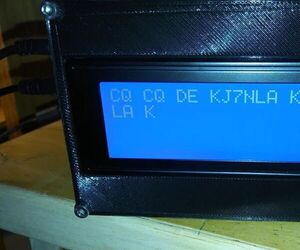
Morse Code Iambic Trainer and Decoder
"In Amateur radio, Morse code is used to send messages using a series of short or long pulses which are heard by the operator as audio beeps. The short beeps are known as dots or dits, and the longer beeps are known as dashes or dahs. To be understood, the duration of the dits and dahs as well as the spacing between dits and dahs (the inter-symbol timing) and the spacing between letters and words must all meet the Morse code timing standards. In the early days of Morse code, single-lever keys (e.g. the J-38 key) were used which required the operator to manually control all timings. Now most operators (except for the single-lever purist) use a double-lever key known as an iambic key or iambic paddle." [...]

IR Based Line Following Robot From Scratch (No Microcontroller)
"In this instructable we'll use the concept, reflection of infrared radiation to built a circuit which can detect the difference between black and white coloured surface. That might not sound interesting but later we can use that circuit to build a robot which will follow a black line, and the best part is, the whole build is purely based on electronics and no programming or coding is required! If you are getting started with electronics or getting a concept of science into a project this would be a great place to start. So, grab the components mentioned below and get started with the instructable. hese are the list of products which can help you do this project with ease Resistor Kit IR module Potentiometer Kit IR LED Pairs Red LED PCB BO motors & Wheels Copper Clad L293D IC Caster wheel (alternative) Capacitors Header pins Lithium Battery with charger" [...]

Soldering Microscope From SLR Zoom Lens and TV Wall Mount
"Firstly I wish to thank Instructables and all the contributers helping me in the past!! This is my first time ever to write something like this(let alone anything for the public) on the web for all to see. I like free. I will give for nothing I like to take for nothing. If we all do it then this world would be a better place. I have done quite a few projects in the past scavenging from skips, unwanted junk and recycling the parts." [...]

RoboCat: a Pet Without the Mess
"This will not be a tutorial, just me reflecting on the process and sharing it! Welcome to RoboCat, a cute pet without the mess! The RoboCat responds to any sounds above a certain range and if you press the red button you can give him some love. He doesn't say much, but he's guaranteed to make you feel a little better while working on an intense programming project. Supplies - Arduino UNO - MAX7219 8x8 Matrix Display - SparkFun Sound Detector - 16mm Panel Mount Button (red) - Piezo Buzzer - Adafruit Speaker 8 Ohm - Resistor 10 kΩ - 5v adapter - 4cm MDF Board - 4 cm Cardboard - Dupont Cables - Posca Pens (red & black) - Light Grey Spraypaint - Gluegun" [...]

Run LEDs From 1 Volt
"Having made a couple of home-made batteries which only produced about 1 volts each, I realised that it would be useful to be able to increase this voltage to power a LED light. You may be thinking 'connect 2 in series' but there are disadvantages with this. This voltage booster increases the voltage. It has leads with alligator clips, so it can be used on different projects. It is simple and cheap to make. " [...]

OpenRPNCalc
"OpenRPNCalc is a scientific calculator based on STM32 microcontroller. Its source code, schematics and 3D-printed case design files are released under open license. The hardware is inspired by the SwissMicros DM42 calculator (which itself mimics the famous HP-42), but designed from scratch. Firmware-wise, however, there is no intention to simulate programmable HP series. Currently, the calulator features: - Reverse Polish notation with 4-element stack. - Double-precision arithmetics." [...]

jank
"just another keypad 21 mechanical keys configured as a numerical keypad plus 4 programmable macro keys. Another write-up can be found at clews.pro. The main features of this keypad include: - HID compliant USB peripheral using an ATmega32U4 microcontroller with connectivity via a USB type-c connector configured as a USB 2 device. Power is also derived from the USB port. - 21 mechanical keys (gateron blues which are pin-compatible clones of Cherry MX switches) with variable brightness white LED backlight on each key. - In addition to the 17 standard keys of a numerical keypad, there is also a row of four keys across the top of the device which are programmable macros." [...]
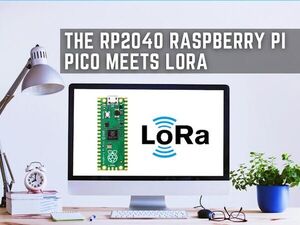
The RP2040 Raspberry Pi Pico Meets LoRa
"In this post, we'll go over everything you need to know about the Raspberry Pi Pico Lora Expansion The Raspberry Pi Foundation's "Pico" board, which uses the RP2040 microprocessor, is the newest compact, fast, and adaptable Arduino Nano board. The board may be programmed using MicroPython and C/C++, as you may know. In this post, we'll go over everything you need to know about the Raspberry Pi Pico Lora Expansion. Raspberry Pi Pico LoRa™ Expansion is a low-power data transmission board that includes an onboard CH340 USB TO UART converter, Voltage Level Translator (74HC125V), E22-900T22S/E22-400T22S SMA antenna connector that covers the 868MHz/433MHz frequency bands, Onboard 1.14" LCD, IPEX antenna connector, and LoRa™ Spread Spectrum Modulation technology with auto multi-level repeating. Pico LoRa™ Expansion can now be purchased on SB Components with two different frequency 868MHz/433MHz. " [...]
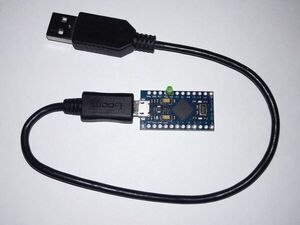
MouseMover
"Moves the mouse cursor a tiny amount occasionally, simulating the user being at the computer, preventing the PC from going to sleep/lock. Overview Having worked in corporate America for the better part of 40 years, I’ve seen corporate computer security policies change over that time from almost none to nearly insane. Today many IT groups force the computers they maintain to require a password to be entered if the computer goes to sleep, which can occur in as few as 5 minutes, in some cases. A recent employer of mine also went to a two step authentication scheme using your password and a token device that displays a set of numbers that also have to be entered as a second password. While this security is nice and sometimes essential, it can be very annoying if you actually need to get something done (besides entering passwords). I can’t count the times I’ve been interrupted at my desk by a conversation with a co worker only to find that when I get back to my computer, the screen has gone to the lock screen and I have to enter the password and a token value to continue." [...]

Portable Foldable Scoreboard
"A portable, scalable and foldable display, that can be used as a Scoreboard or Timekeeper in outdoor sport events, with minimal setup A simple, scalable and foldable display, that can be used as a Scoreboard or Timekeeper in sport matches. Quite useful for indoor and outdoor sports, as it's very easy to setup (all you need is a place to hang it!). The visibility is really good, it can be easily read from 50+ metres, even in sunny days Display is made with the popular WS2812 strips. The current prototypes use the IP65/30 version, fixed into PVC bars. The 15x9 resolution can then be achieved with a single 5m strip The frame is based in modified 3dprinter cable chain slabs, with fixings to held the PVC bars with the leds. The vertical separation of each bar matches the strip horizontal distance between LEDs, to keep the aspect ratio." [...]

Hearing Substitution Using Haptic Feedback
"Exploring AAC to substitute hearing through Neosensory Buzz's haptic feedback for deaf parents to connect to their kids. Deaf People Parenting Hearing Children Ever wonder how difficult it is for deaf people parenting hearing and speaking children, since infant to teen and beyond? Newborn babies do not speak. Only communication they know is to cry. They cry when hungry, they cry when fussy, they cry when in pain. Imagine a deaf parent, little way from babies crib, they hear nothing!" [...]

Long term dust monitoring using GP2Y1014AU0F and Blynk
"Monitor the surrounding dust and large particle (>0.5µm) for long time using Blynk IOT and plot the data for further research. In this project I have made a IOT based Dust density monitor which can measure the surrounding dust and send the data through internet and I can graphically monitor the long term value of the dust density in a place. This can helps to make future project like improving the air pollution and many other projects. Sharp gp2y1014au0f is a particulate sensor uses an IR LED and when the particle in the air enters into the sensor the light bounce off towards a photo-detector. This technique is called laser scattering. The intensity of the scattered(Bounced) light depends on the dust particles." [...]
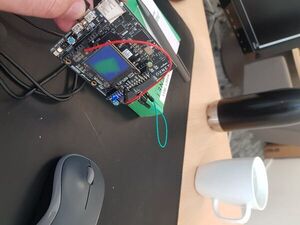
Portable Thermal Imaging with the MiniZed
"Create a low cost and portable thermal imaging solution for accurately measuring temperature. Introduction I have previously looked at the top end of the low cost thermal imaging solution with the use of the FLIR Lepton coupled to HDMI displays or the Avnet touch screen display, Recently I came across two components from pimoroni which I thought would be very interesting to make a compact portable thermal imaging solution based around the MiniZed. These are the 1.3 Inch Colour TFT LCD which has an SPI interface and the MLX90640 IR Thermal camera which provides 32 pixels by 24 lines thermal image. Both of these can be made to connect to the MiniZed with a little thought and would produce a simple low cost thermal solution. Connecting the Thermal Camera and LCD The thermal camera uses a I2C interface, while the LCD uses an SPI interface, both of these can be easily implemented with the MiniZed PS. However connecting the devices required a little thought as neither can be directly plugged into the board." [...]

Temperature Monitoring System Using Bolt IoT
"This project is an evident example of IoT in action. The project deals with the sensing of temperature with the help of LM35. Introduction It is very important in pharmaceutical industry to maintain the temperature of the medicines in the threshold range and it's very important to inform the owner if the temperature is about to go beyond the set threshold value, my project does exactly the work of saving lot of products from damaging by informing to owner even before the temperature reaches beyond the threshold value set. Hardware Components We need the following components to build the whole project: - Bolt WiFi module - LM35 Temperature sensor - 3Jumper wires ( Male to Female ) - Micro-USB cable ( mobile charger can also be used ) - Power Source ( power bank can also be used )" [...]

ESP32 Plant Monitoring with Arduino IOT Cloud Remote App
"Real time plant monitoring system to view temperature, humidity and soil moisture using ESP32 (Magicbit) board and Arduino iot cloud App. Monitoring plant health is very important for their fast growth. In this busy world, people usually forget to water their plants which leads to bad growth and health of their plants. For ensuring complete development of plants it is necessary to develop proper surrounding conditions in which plants grow. We are now going to make a small Plant Monitoring system whose data will be displayed on the arduino iot cloud remote app.In this project we are using ESP32 based development board Magicbit. The iot remote app will display the following data: - Moisture sensor will sense the amount of moisture present in the soil." [...]

Low power ESP8266 sensor data logger
"This tutorial demonstrates how to make an ultra low power sensor data logger running on 2 AA batteries for more than a year. Recently I tried to make a data logger using ESP8266, to periodically upload temperature/humidity/moisture measurements to a Google Sheet. The intended use is outdoor, so the device can only be battery-powered. It turned out the popular NodeMCU boards are not very power efficient, and only last for a couple of weeks before the batteries run out. After a bit of research, I made the data logger using ESP-12F (a variant of ESP8266). It has amazingly low power consumption, only 20uA in deep sleep mode." [...]

DHT22 Data to Google sheet Using ESP8266 without credential
"Here the DHT22 sensor is connected to ESP8266 NodeMCU and ESP8266 NodeMCU is connected to Internet through WiFi to send the DHT22. Here the DHT sensor is connected to ESP8266 NodeMCU and ESP8266 NodeMCU is connected to the Internet through WiFi to send the DHT22 readings to Google Sheet. " [...]
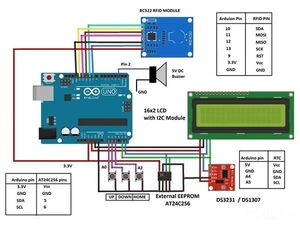
RFID based Attendance system using Arduino and External EEPROM
"In this post we are going to learn how to build a RFID based attendance system using Arduino development board, RC522 RFID reader module and external EEPROM. We will take a brief look at RC522 RFID module, external EEPROM and other circuit modules that makes this proposed RFID attendance system work. RFID card based system is so commonly used in our modern life such that you must have come across at-least one point in your life at schools, offices, train stations, libraries etc. In this post we will learn how to build an attendance system that can store attendance of 100 people and 255 attendance counts per person. Circuit description: The proposed circuit consists of the following module that makes this RFID attendance system possible: ·RC522 RFID module. ·External EEPROM AT24C256." [...]

Robotic Arm (with linear actuators)
"I have made a different type of design than the normal robotic arms, based on linear actuators. Robotic arms are used in many applications, ranging from heavy-duty assembly lines and warehouse logistics to precise equipment for fine operations. There are many types of such machinery, based on the application, they can be operated with hydraulics, pneumatics, electrical or mechanical power sources. About this project This project is rather a concept in which I combined a side of mechanics (linear actuators) with a simple robot - a robotic arm. This model is far from perfect, but it is a robot that is flexible and can lift weights to 100 grams. Therefore, any improvement of this project is welcome." [...]
Secção Videos
Videos interessantes.
That's all Folks!








